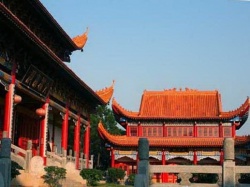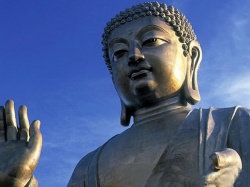Book of Space
SPACE..."The Tibetan Book of the Dead is actually a 'Book of Space.' Space contains birth and death; space creates the environment in which to behave, breathe and act, it is the fundamental environment." (Trungpa: Tibetan Book of the Dead: 1975...pg 1)...."three kinds of absolute emptiness or space: 'mkha' is external space conceived without consideration of the things contained within it. 'kLong' is the space of objects that exist within the mkha...and dbying is the space of direct experience as such." (Wangyal: 1993..pg 118)...
EGYPT..."The ancient Egyptian King had the obligation to maintain a divine order called 'maat'. The Egyptian notion of 'vital force' was called 'Ka'. The ka is born with the King as his twin and his protective genius. The placenta was sacred and buried under his Ka tree. To die is to go to one's ka. Death is a crisis during which the vital force, the ka, leaves the body. The god is the Ka of the King. The Ka is power. The Ka is an impersonal vital force which can charge any object. The 'Ba' is bird shaped, with human head and arms. The Ba possesses power. (Frankfort: "Kingship and the Gods", Chicago: 1948, pg 61)...
SHINTO: ...Being saved is a foreign idea in Japan...When you look into the mirror you know who you are deeper. Knowing is important. Deeper knowledge is important." (Yamamoto Negi of the Tsubaki Grand Shrine at RMSC in 1992)....."Thirty three years after death, the Shiryo (spirit of the departed) is to become an ancestor god."..(Crump: 1990..pg 91)...
PERSIA...In the Persian tradition, 3 days after death the deceased sees its own 'daena' in the shape of a beautiful 15 year old. Ascends through three spheres to the 'light without beginning'. (Ency Brit)..."A significant question in the Pahlavi Texts is whether the soul (ruvan) is conscious of suffering while the body (tan) is resolved into its elements (banjism) at death. Life is 'jan'. Consciousness is 'bod". (Pavry: 1929...pg 16)
BARDO: (bar do; Skt. antarabhava) Literally, between two. In general any interval , a between. Six bardos are usually spoken of 1.) Death Process (chi kay bar do) the interval from the moment when the individual begins to die until the moment when the separation of the mind and body takes place. 2.) Cho nyi Bardo: the interval of the ultimate nature of phenomena when the mind is plunged into its own nature. The first phase of the after death process. 3.) The Bardo of Becoming (si pay bar do) the interval in which the mind moves towards rebirth. 4.) The Bardo between Birth and Death (chi shi bar do) Ordinary waking consciousness during the present lifetime. 5.) Dream (mi lam bar do) the dream state we experience in sleep. 6.) Meditative concentration (sam ten bar do) the state of meditative stability. The first three are the intermediate states after death and before the next birth, It is said to usually last forth-nine days. When you are in a state of bardo you are stuck in a particular vacuum. Because of your intense desire to maintain your habitual patterns, you replay your own tapes again and again. You are locked in your own mind and you create your own world. One of the six yogas; intermediate state.
DEATH: (V73p160) the real message; when death occurs, you have a chance to relate with the deities, because death is one of the fundamental, resounding sounds of thunder, the real fundamental message. According to the tantric teaching, there are many different varieties of death and after death experience, depending on the individualities of karma, illness, and especially the evolution of someone's realization. In the case of great masters who have already attained complete realization of mahamudra or maha ati in this very life, they are already liberated in the dharmakaya, and the death of the physical body does not change anything for them. The analogy is given that the space inside a vase is the same as the space outside. When the vase is broken, the space within and the space without merge. In the case of ordinary people, as death approaches, touch, hearing, sight, and the other senses dissolve inwardly. Consciousness tends to become dim, unsteady, and hallucinatory. As consciousness dissolves the outer breathing stops. It is taught that then in quick succession the subtle forces resulting in aggression-based, passion-based, and ignorance-based mental conceptions dissolve. Then as even the deep inborn ignorance of the alaya consciousness dissolves, for an instant as long as a finger snap there is the basic clear light, or the ground luminosity, or the bardo of dharmata. This is the sugatagarbha, the dharmakaya itself. Yogins who recognize it can attain liberation at this moment. However, ordinary beings who have not practiced experience this only as unconsciousness, so they recreate the inborn ignorance, the karmic tendencies, the visions of the bardo of becoming, the compulsive samsaric rebirth. In the ordinary case, after rigor mortis subsides eight to twelve hours after the outer breath has stopped, the connection between body and mind has completely dissolved. At the moment of death, the only thing that can help us is practice. Death is the experience of Dharmakaya, reality. To the non-practicioner, it can be terrifying. Death takes away everything. We have to leave alone. The only thing that follows us are positive and negative actions. No possessions or family or friends. Yidam dieties will guide us on the path. Have total confidence, no panic or fear. Practice is essential. Remove delusions. At the moment of death, body and consciousness separate. You have to apply te teachings you have received. Clingings and graspings and habitual patterns have to be let go of. Remember the instructions. One pointed concentration. The yidam will correct false views that develop after death. ave confidence. Death is state of enlightenment. We have a mental body. Gross body has been left behind. No freedom or control. Restless. Mind can be very wild without body. Very sensitive with our perceptions. Those with celestial eyes have good training. Visions and experiences occur. Strong winds appear. Strong storms. No external light. Not clear. Have to wander. Nightmare develops. Mental perceptions. Very terrifying. Practicioners of dream yoga will realize the perceptions as not true. The moment they realize this the perceptions will fade away. Mental projections. Practicioners will recognize it as a display of the yidam diety. Your ability to recognize this will free you. It's similar to a movie. You can get very involved. May take it seriously. But there is nothing in front of us. Holding on will create extremely unpleasant experiences of death. Death for the practicioner is nothing but the experience of the state of dharmakaya."

